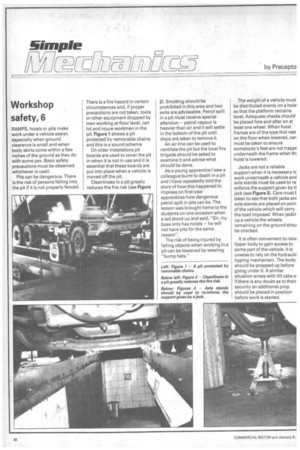Workshop safety, 6
Page 42

If you've noticed an error in this article please click here to report it so we can fix it.
RAMPS, hoists or pits make work under a vehicle easier, especially when ground clearance is small and when body skirts come within a few inches of the ground as they do with some psv. Basic safety precautions must be observed whichever is used.
Pits can be dangerous. There is the risk of persons falling into the pit if it is not properly fenced.
There is a fire hazard in certain circumstances and, if proper precautions are not taken, tools or other equipment dropped by men working at floor level, can hit and injure workmen in the pit. Figure 1 shows a pit protected by removable chains and this is a sound scheme.
On older instalations pit boards are used to cover the pit in when it is not in use and it is essential that these boards are put into place when a vehicle is moved off the pit.
Cleanliness in a pit greatly reduces the fire risk (see Figure 2). Smoking should be
prohibited in this area and two exits are adviseable. Petrol spilt in a pit must receive special attention — petrol vapour is heavier than air and it will settle in the bottom of the pit until steps are taken to remove it. An air line can be used to ventilate the pit but the local fire brigade should be asked to examine it and advise what should be done.
As a young apprentice I saw a colleague burnt to death in a pit and I have repeatedly told the story of how this happened to impress on first-year apprentices how dangerous petrol spilt in pits can be. The lesson was brought home to the students on one occasion when a lad stood up and said, "Sir, my boss only has hoists — he will not have pits for the same reason".
The risk of being injured by falling objects when working in,a pit can be lessened by wearing "bump hats."
The weight of a vehicle must be distributed evenly on a hois. so that the platform remains level. Adequate checks chould be placed fore and after on at least one wheel. When hoist frames are of the type that rest on the floor when lowered, car must be taken to ensure somebody's feet are not trappc underneath the frame when till hoist is lowered.
Jacks are not a reliable support when it is necessary tc work underneath a vehicle and axle stands must be used to re enforce the support given by tl jack (see Figure 3). Care must taken to see that both jacks an axle stands are placed on poin of the vehicle which will carry the load imposed. When jackir up a vehicle the wheels remaining on the ground shou be checked.
It is often convenient to raisc tipper body to gain access to some part of the vehicle. It is unwise to rely on the hydraulic tipping mechanism. The body should be propped up before going under it. A similar situation arises with tilt cabs a if there is any doubt as to their security an additional prop should be placed in position before work is started.










































